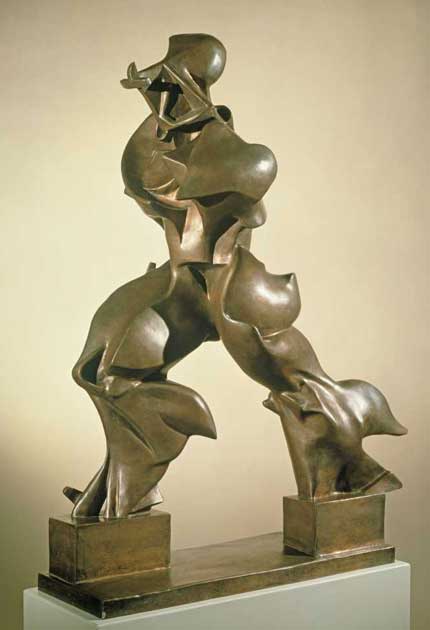Unique Forms: The drawing and sculpture of Umberto Boccioni, Estorick Collection, London
What the future looked like then

Some shows need not be very big to be significant. This is one such. Umberto Boccioni lived a short life – he died during the First World War, at the age of 36, by falling from a horse – but what he did helped to define the nature of Italian Futurism. He was one of the co-signatories, with Marinetti and others, of the manifesto of April 1910, which marked the birth of the movement. He was one of its makers, but he was also its theoretician and its aesthetician. Lovely words for a brutally probing mind.
So, on the wall of a single gallery at the Estorick Collection of Modern Italian Art, we see drawings, a few paintings and just two sculptures. In spite of the fact that there is not much, it is still too little space for what there is. The work feels too squeezed in, too pent, as if it's roaring to expand into more generous spaces. There would have been yet more wonderful sculptures – you can see some dramatic, recently discovered photographs of them on the wall here, taken by Boccioni himself in 1913 – had not a fellow-artist smashed up Boccioni's work after his death because he was sorely in need of some plaster for his own art.
Boccioni's gift was to bring a fresh eye to reality in ways that, we now recognise, defined the nature of the modern movement in the visual arts and literature, too. For it so happens that it was in this year, too, that Virginia Woolf was making similar kinds of claims about the representation of the modern in literature. What Boccioni said was this: life is not a stationary thing. It fizzes, it fragments, it unfolds unceasingly from second to second. It is both what we see and what we are always ceaselessly becoming as human beings. Art's role was, somehow, to show life's inner and outer dynamism. Painting is not about what we observe, as if life were nothing but an interesting still life of bottles and an apple. It is also about what we remember, or what we thought we remembered, or what we thought we remembered that we saw. What a juicy maelstrom of complexity!
Other movements, and other artists, were drawing our attention to the complexity of modern life at about this time, too. Picasso, over in Paris, for example was experimenting with simultaneity in Cubism, showing an object, a person, from a number of different angles. But that wasn't good enough for Boccioni. Picasso's Cubism was too static. It didn't show you the thrust, the flow...
Which is precisely what Boccioni endeavoured to do in Dynamism of a Human Body, a drawing-cum-painting in tempera and ink of 1913. Here you see the human form moving in all directions at once, thrashing and squirming about in a lashing of curves. There seems to be a whole heap of bodies here, behaving orgiastically perhaps, but the idea, I think, is to represent bodily movement in the abstract, the essence of the idea of bodily movement, perhaps.
Sometimes, Boccioni does very silly things to make his point – he represents "lines of force" as sequences of straight lines rocketing out in one direction or another. This seems not only unsubtle, but also infantile. The best piece in the show is a sculpture – on loan from the Tate – entitled Unique Forms of Continuity in Space. It shows an indomitably muscular figure striding through space. It is a heroic piece, which stinks of Hellenism. Every part of it is flame-like. The flames are greedily lapping up the body, consuming it insatiably. As you circle it, it seems to turn with you. Its spikiness suggests power, speed, the forward thrust of the human.
To 19 April (020-7704 9522)
Subscribe to Independent Premium to bookmark this article
Want to bookmark your favourite articles and stories to read or reference later? Start your Independent Premium subscription today.

Join our commenting forum
Join thought-provoking conversations, follow other Independent readers and see their replies